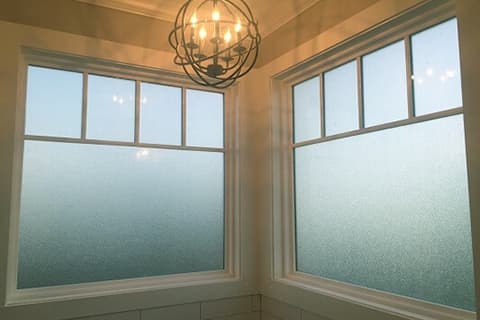
Glass is an integral part of what we see in the world. It can be transparent, reflective, or tinted to serve a variety of purposes. One such purpose is privacy – what type should you use for this?
This blog post will explore what types of glass are best for privacy and their strengths and weaknesses. We’ll also look at how they may be used in different settings (homes, offices) as well as what your budget might allow you to purchase!
Translucent glass
Translucent glass is what we often refer to as frosted glass. It is made from a clear sheet of glass, sandblasted or acid-etched (to create the opaque effect). During this process, light passes through, but it also diffuses and scatters, causing images to become blurred while still allowing plenty of natural light into an area.
This type of glass can be used in a variety of places to provide some level of privacy, including:
• As window dressing for small spaces such as window seats or walk-in robes.
• For shower screens and bathroom walls.
Translucent glass is typically not designed to entirely block out light but simply diffuse it to be more comfortable to be in. It also has the advantage of being able to see through from one side of a space (e.g., into your living room) as well as adding privacy between rooms or apartments, without completely blocking out light and views from other areas entirely.
One thing you’ll notice with translucent glass when looking at it from the outside is that it appears to be frosted, which gives a nice finish to your windows without creating complete darkness. This can add an exciting touch or provide some privacy for small spaces like bathrooms but still allow you to see what’s going on in other rooms/areas of the house.
Translucent glass has two main weaknesses. One is that it is not designed for blocking out light or noise entirely. If you have a larger space with multiple openings to other areas (e.g., large windows), there may be some sound and/or visual leakage between rooms. The second is that you can see what’s going on in your room but cannot thoroughly lookout (e.g., into the street) without encountering a blurred image, which could be considered an invasion of privacy if you are not expecting it!
Translucent glass is typically used in small spaces where noise or light leakage may be more tolerable (such as within your home), but you still want some level of privacy to get away from it all.

Textured glass
Textured glass is one of the most popular types of glass used to provide privacy. It is created by placing a patterned mask in front of a sheet of clear or colored glass and then blasting it with sand (or another material) at high speed, leaving an imprint on the surface.
Textured glass can be made in any design you want, but the most common (and most straightforward) is a repeated grid or chevron pattern. This glass can be up to lookout40mm thick and comes with either clear, tinted, or reflective finishes.
The strength of textured glass lies in the fact that you can see out clearly, but people cannot look in without your knowledge – you can see out, but you can’t make out details of what is on the other side. This makes it a popular glass choice for living rooms, bedrooms, and home offices where privacy is essential (e.g., if you have work done in your house or apartment). This also works well for businesses looking to provide some level of privacy without deadening sound or light.
The textured glass comes in a range of finishes and thicknesses, affecting its overall strength or level of privacy. The thicker the glass (e.g., up to 40mm), the stronger it is – if someone tries to look through it or break the glass, they won’t see it as clearly. Thinner (e.g., 20mm) textured glass is more suited for smaller spaces that you don’t want anyone looking into but still need some light and views from other areas of your home/apartment.
Smoked glass
Smoked glass is another option for increasing privacy. It is clear glass that has been treated with a thin layer of metallic oxide, which creates an opaque effect and blocks out images from the other side – you can see through, but it’s like looking into the fog.
Smoked glass screens are usually around 20mm to 25mm thick and come in reflective or non-reflective finishes, with metallic or non-metallic oxide layers.
Smoked glass has the advantage of seeing out and giving a mirrored look if you want it, but it is also solid enough that people will only be able to see your silhouette or shadow when looking in. This makes it an excellent choice for bedrooms, living rooms with more oversized windows (e.g., French-style doors), bathrooms, and other smaller spaces where you want a bit more privacy.
Smoked glass is relatively non-porous compared to textured or frosted glass, so it will not collect watermarks if left untreated. It can also be cleaned the same way as regular clear/reflective glass – with window cleaner, squeegee, etc.
Colored glass
Colored glass is crystal clear glass with a coating applied to it, which changes the way light passes through by either absorbing or reflecting colors.
The most common form of colored glass is green (or ‘Avonite’) due to its high level of privacy and ability to block out almost all-natural light – perfect for areas where you don’t want people looking in but still need to see out.
Colored glass is usually around 20mm thick and comes in a range of finishes, including clear (for maximum privacy) or tinted with dark or light tints available depending on the level of privacy you are looking for. Colored glass can also come pre-coated with a UV-resistant film, which protects the glass from fading due to exposure to sunlight, which can happen with untreated windows.
Colored film on this glass door not only provides a point of interest but serves as a dramatic focal point, throwing a range of colored light onto the surfaces like a modern version of a stained-glass window.
Glass bricks
Glass bricks are decorative glass blocks that can be used to create privacy walls, screens, and partitions – just like masonry bricks. Glass brick panels offer good visibility through them, so you don’t lose natural light but provide privacy from the other side.
Using glass bricks to create partitions and screens is a quick, easy way of adding privacy where you need it in your home or apartment without having to sacrifice natural light.
Glass bricks come in two forms – clear or textured. Clear glass brick panels are often used behind a kitchen counter to create privacy and separate the cooking area from an eating/lounge area while maintaining a visual connection with the rest of the space. Textured glass bricks can be frosted (with added light diffusion) or have patterns etched into them (e.g., a wave pattern). These are often used in the bathroom and laundry to create privacy while still allowing light or views out of the window next to it and adding visual interest through their look and texture.
Switchable privacy glass
Switchable privacy glass turns from clear to opaque in less than 0.01 seconds. How and when it does this is up to you – the client, as each room, will vary depending on how much privacy people need at different times of day or night (e.g., for sleeping, changing, etc.).
Switchable glass works by applying an electrical current to the glass, which activates its smart properties. This can be done via a wall switch or remote control system tailored to each user’s individual needs (e.g., room location) – so you could activate it from your bedside table if needed!
Homeowners looking for a stylish alternative to curtains or blinds could consider switchable privacy glass as an option because it offers similar benefits of controlling natural light levels but with the added advantage of privacy. It can be used as a partition wall or for more oversized glass sliding doors in the home to keep natural light but maintain privacy when you want it.
Switchable glass could be the perfect solution for bathrooms and other smaller rooms where you don’t need much/any natural light but still want some level of visibility out into your living space.

Leadlights
Leadlight windows, or leaded light windows, consist of many small, individually cut and processed glass pieces joined permanently together to form a glazing panel. The glass is secured and sealed watertight using either a soldered-shaped lead strip known as a “came” or edged and soldered together through a copper foil tape.
Leadlight windows can be created in a range of different shapes and styles. Still, they are usually large sheets that run vertically or horizontally across the window exterior to let light into the room while maintaining privacy from outside.
In conclusion, many different types of glass can be used in your home to create privacy. Some options come pre-coated, while others require you to apply a film yourself or need electricity for it to work.
However, switchable glass is ideal for the best privacy and light control but a stylish look that will complement your home décor. It offers excellent levels of visibility or privacy when needed without compromising on natural light leading to an enjoyable living space where you can relax whether it’s day or night.
